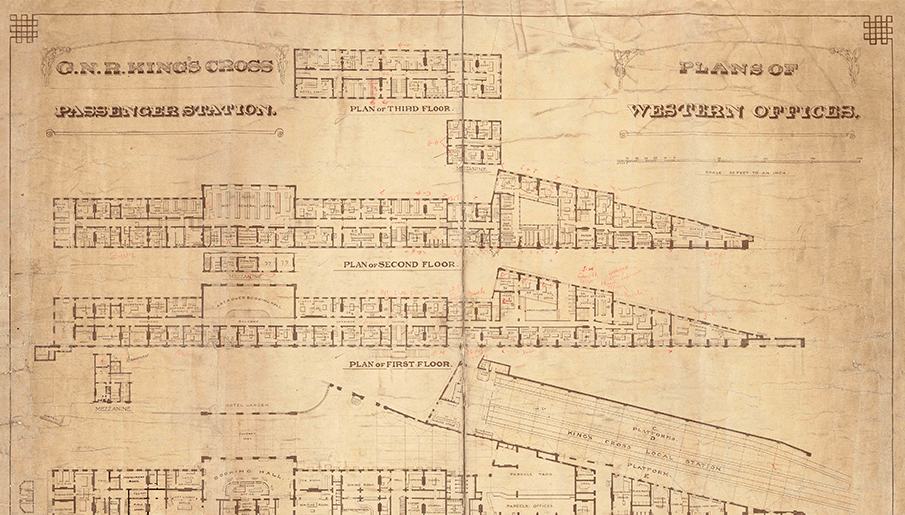The history of London King’s Cross station
The story of London King’s Cross station is one of decline and renewal.
Commended for its simplicity when it opened, the station soon became overcrowded as rail traffic increased in the nineteenth century.
Although a major transport hub, the twentieth century was not kind to the station, but recent investment in both the infrastructure and the surrounding area has made King’s Cross a destination station once again.

Simple and functional
The Great Northern Railway reached London in 1850, opening a temporary wooden terminus at Maiden Lane (now York Way) whilst its new station and the approaching Gasworks Tunnel under the Regents Canal were being constructed. Planned for a 10 acre site in the area known as King’s Cross the new terminus was built on the site of a smallpox and fever hospital and at the junction of four roads; New Road (Euston Road), Maiden Lane (York Way), Pentonville Hill (Pentonville Road), and Gray’s Inn Road.
King’s Cross Station was opened to passengers on 14 October 1852. Designed by Lewis Cubitt to be simple and functional it was at the time the largest railway station in Britain. Two train sheds both 800ft long, 105ft wide and 71 ft high are closed by a plain brick screen 216ft long with two large arched windows and with a porch of six arched openings, three each side of the square Italianate clock tower 112ft high which is the stations only ornament.
Primarily for main line traffic inside it had just two passenger platforms, one for departures on the west side, the other for arrivals on the east side. King’s Cross had an additional six platforms for the storage and movement of locomotives and carriages in the middle. On the east side of the station arches from the arrivals platform led to a cab road while on the west side station facilities such as waiting rooms, refreshment rooms and a ticket office were provided as well as company offices and the Great Northern Railway boardroom.
Demand grows
Throughout the nineteenth century passenger traffic into King’s Cross increased significantly, putting a great deal of strain on the functionally designed station. All eight platforms in Cubitt’s original building were utilised, and an additional three platforms for suburban traffic were added to the west of the building to cope with demand.
Additional lines and tunnels were added to the approach to King’s Cross to increase flow and improve difficult working conditions for engine drivers. A significant goods depot on and around the site of the temporary Maiden Lane station developed to the north of King’s Cross as the Great Northern Railway moved coal and fresh produce from the North to the Capital.
Intercity, suburban and underground
In the twentieth century King’s Cross and its surrounding area became a significant transport hub, with intercity, suburban and underground services, but the station showed signs of serious decline. Suburban trains passed through King’s Cross from 1866 until 1977 using the ‘York Road’ platform to the east of the station, travelling south towards Moorgate.
Travelling in the opposite direction they passed through the suburban platforms to the very west of the station. York Road and suburban platforms closed on 4 March 1977. Suburban and regional services now terminate at King’s Cross using platforms 9, 10 and 11. Intercity services use platforms 1-8.
When King’s Cross opened, a large number of huts and kiosks sprang up at the front of the station, trading on the passenger and goods traffic concentrated in the area. In the early 1970s these kiosks were cleared and a single story travel centre, ticket office and concourse opened to the front of Cubits façade, but it made little impact on the overcrowded and restricted passenger facilities.
The 21st century
Since 2002, £2.5 billion has been invested in the transport infrastructure in and around King’s Cross. Improved access and facilities for London Underground at King’s Cross St Pancras were opened in 2009, and a new ‘platform 0’ was opened on the east side of the station in 2010 (utilising the old cab road) to create extra capacity in the station.
A new steel and glass Western Concourse by John McAslan & Partners opened in March 2012, making use of the space between Lewis Cubitt’s Great Northern Hotel and the offices on the western side of the station. The final phase of the redevelopment started soon after with the removal of the 1970s concourse and travel centre. This enabled Cubitt’s original Grade 1 listed façade to be exposed once more as well as a square at the front of the station, creating a new public space right in the heart of London.
Did you know?
The area known as King’s Cross got its name from a statue of King George IV erected at the crossroads outside the station. The monument itself was short lived, being completed in 1836 and demolished in 1845, but the area retained the name.